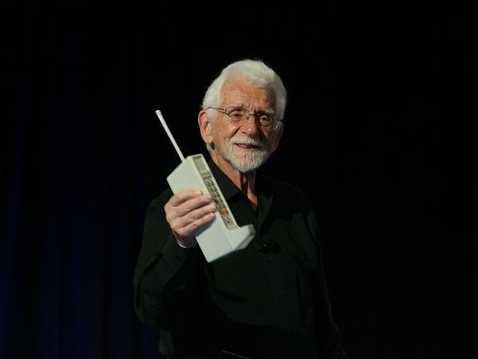 Forty years ago today, a Motorola engineer named Marty Cooper made what has gone down in history as the world’s first cellphone call, dialing a rival at AT&T from a hand-held mobile phone while standing on a sidewalk in New York City, just to show that he could.
Forty years ago today, a Motorola engineer named Marty Cooper made what has gone down in history as the world’s first cellphone call, dialing a rival at AT&T from a hand-held mobile phone while standing on a sidewalk in New York City, just to show that he could.
On April 3, 1973 in midtown Manhattan, Marty Cooper, a Motorola engineer, called his rival, Joel Engel, at Bell Labs.
“Joel, this is Marty,” Cooper said. “I’m calling you from a real handheld portable cellphone.”
It’s amazing to think of how far mobile technology has come in just 40 years. After all, it wasn’t until 1992 that the first commercial text message was sent, and games didn’t make it to mobile phones until Tetris, in 1994. It took another 10 years to develop the first Wi-Fi-enabled phone, and the pace has drastically picked up since then.
Cooper made the first mobile phone call on a Motorola DynaTAC 8000x, a device that was nine inches long, weighed 2.5 pounds, and took 10 hours to recharge a battery that could only handle 35 minutes of talk time. Compare that with the Samsung Galaxy S3, which is just over 5 inches long but only weighs about 0.3 pounds and can hold a charge for several hours while the user talks, texts, surfs the Web, plays games and listens to music.
What does the future hold for cellphones? According to an infographic put together by Cisco to celebrate the anniversary of cellphones, there will be more than 10 billion mobile devices around the world by 2017. It also predicts mobile video alone will account for 66 percent of all mobile data traffic.
It was an impressive technical feat at a time when people didn’t even have cordless landline phones yet. But the press wasn’t exactly bowled over. Anyone who thinks 21st-century tech bloggers invented the snarky takedown of a promising new technology should have a look at the Associated Press report that ran in newspapers across the country the next morning:
New York, N.Y.—AP—Dick Tracy may have pushed it. A television set in a wrist watch, for heaven’s sake. But that telephone in the secret agent’s heel is almost here—if you’re the Jolly Green Giant, have a jolly green bank account and can wait until 1976.
That’s when Motorola, Inc., hopes to come out with its portable phone, a little under eight inches long and weighing less than three pounds, yours for a basic charge of $60 to $100 per month, plus tolls.
Carry it to the beach, the supermarket, the yacht, the fox hunt, the golf course, the hideaway where you went to get away from it all.
Zing! In fact, the skepticism was warranted—all the way up until it wasn’t. Thanks to technological, regulatory, and infrastructure hurdles, it was another decade before a Motorola executive made the first commercial wireless call on a Motorola DynaTAC phone, in October 1983. And it wasn’t until the 1990s that handheld cellphones began to achieve mainstream popularity.
The intervening 20 years offered plenty of time for people to both play up and pooh-pooh their potential. A 1981 story in the Christian Science Monitor tried to demystify the technology for readers by leading with an example of how they might use it:
It’s 2 in the afternoon and you’re starving. Breakfast was half a tangerine and a cookie, but you can’t go to lunch until the branch manager in Pawtucket returns your call. You stare at the phone, your stomach rumbling like a diesel engine, and wish the cord were long enough so you could take the receiver with you to the Burger King next door. Soon you might be able to do just that.
Most reporters were careful to cast doubt on how many would really be willing to pay for that privilege. The Christian Science Monitor piece was headlined, “Really Portable Telephones: Costly But Coming?” A 1980 Washington Post story cited what seemed like an optimistic AT&T marketing study indicating that “as much as 13 percent of the business community would be interested in purchasing one of these advanced systems.” But a few early evangelists—surely mocked by their contemporaries—saw even greater potential. In the Globe and Mail in 1983, Jonathan Chevreau wrote (emphasis mine):
Because of the current high cost to users, the popular notion is that of the high-powered business executive making deals by using a telephone in his car during rush hour traffic. But cellular radio is far more than that—the technology ultimately could replace the ordinary telephone, providing a means of communication that would be as personal as the watch or portable radio.
Indeed, one of the offshoots may be that eventually each person will have a “personal telephone number,” which could remain the same for life.
Far out! But even among visionaries, few believed the technology would ever go quite that far. “Cellular phones will absolutely not replace local wire systems,” one expert source told the Monitor. “Even if you project it beyond our lifetimes, it won’t be cheap enough.”
That naysayer? One Marty Cooper.
Here’s to 40 Years of Huge, Weird, Wonderful Cellphones (VIDEO)

